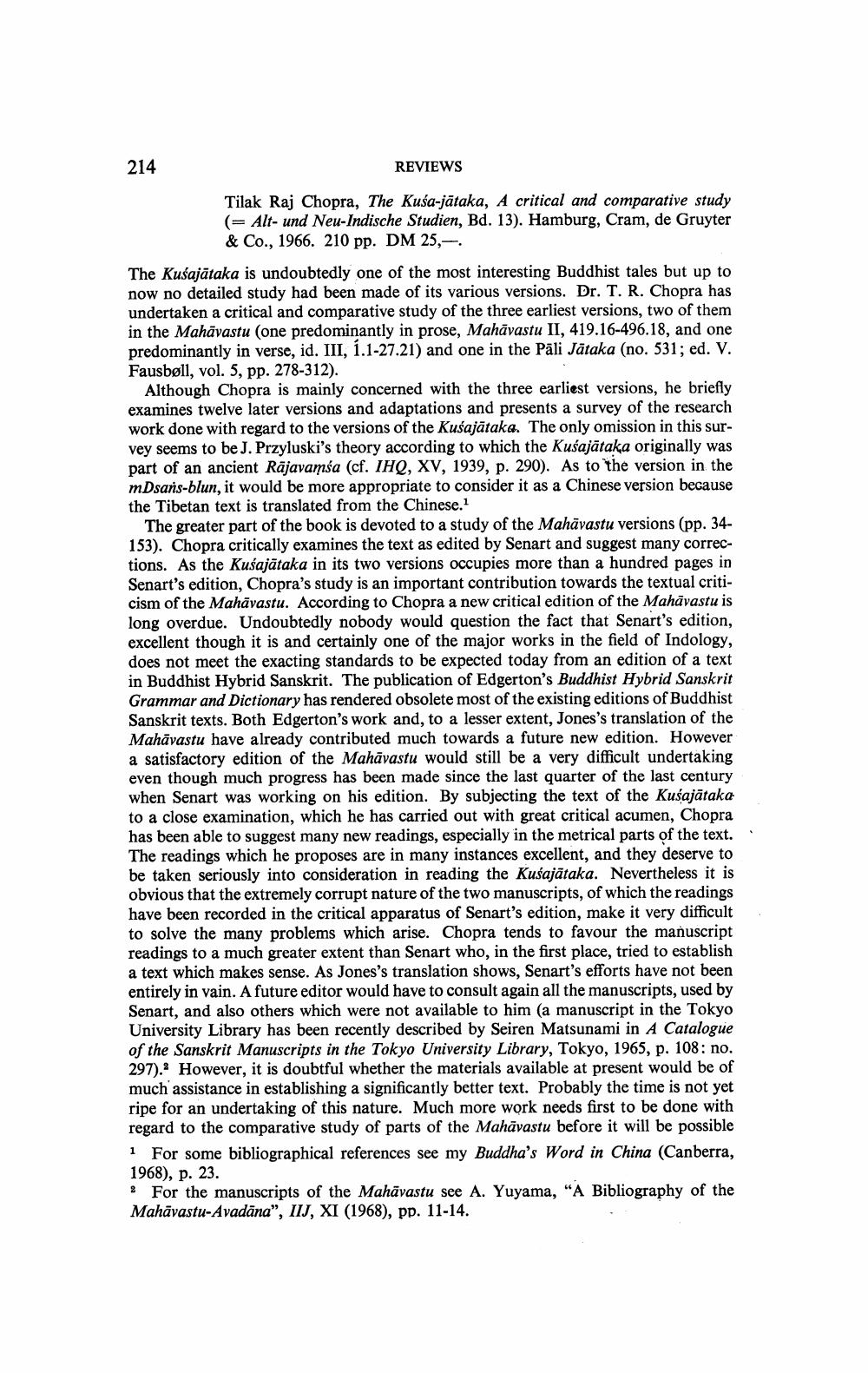Book Title: Reviews Of Different Books Author(s): Publisher: View full book textPage 8
________________ 214 REVIEWS Tilak Raj Chopra, The Kusa-jataka, A critical and comparative study (= Alt- und Neu-Indische Studien, Bd. 13). Hamburg, Cram, de Gruyter & Co., 1966. 210 pp. DM 25, The Kusajataka is undoubtedly one of the most interesting Buddhist tales but up to now no detailed study had been made of its various versions. Dr. T. R. Chopra has undertaken a critical and comparative study of the three earliest versions, two of them in the Mahavastu (one predominantly in prose, Mahavastu II, 419.16-496.18, and one predominantly in verse, id. III, 1.1-27.21) and one in the Pali Jataka (no. 531; ed. V. Fausboll, vol. 5, pp. 278-312). Although Chopra is mainly concerned with the three earliest versions, he briefly examines twelve later versions and adaptations and presents a survey of the research work done with regard to the versions of the Kusajataka. The only omission in this survey seems to be J. Przyluski's theory according to which the Kusajataka originally was part of an ancient Rajavamsa (cf. IHQ, XV, 1939, p. 290). As to the version in the mDsans-blun, it would be more appropriate to consider it as a Chinese version because the Tibetan text is translated from the Chinese. The greater part of the book is devoted to a study of the Mahavastu versions (pp. 34153). Chopra critically examines the text as edited by Senart and suggest many corrections. As the Kusajataka in its two versions occupies more than a hundred pages in Senart's edition, Chopra's study is an important contribution towards the textual criticism of the Mahavastu. According to Chopra a new critical edition of the Mahavastu is long overdue. Undoubtedly nobody would question the fact that Senart's edition, excellent though it is and certainly one of the major works in the field of Indology, does not meet the exacting standards to be expected today from an edition of a text in Buddhist Hybrid Sanskrit. The publication of Edgerton's Buddhist Hybrid Sanskrit Grammar and Dictionary has rendered obsolete most of the existing editions of Buddhist Sanskrit texts. Both Edgerton's work and, to a lesser extent, Jones's translation of the Mahavastu have already contributed much towards a future new edition. However a satisfactory edition of the Mahavastu would still be a very difficult undertaking even though much progress has been made since the last quarter of the last century when Senart was working on his edition. By subjecting the text of the Kusajataka to a close examination, which he has carried out with great critical acumen, Chopra has been able to suggest many new readings, especially in the metrical parts of the text. The readings which he proposes are in many instances excellent, and they deserve to be taken seriously into consideration in reading the Kusajataka. Nevertheless it is obvious that the extremely corrupt nature of the two manuscripts, of which the readings have been recorded in the critical apparatus of Senart's edition, make it very difficult to solve the many problems which arise. Chopra tends to favour the manuscript readings to a much greater extent than Senart who, in the first place, tried to establish a text which makes sense. As Jones's translation shows, Senart's efforts have not been entirely in vain. A future editor would have to consult again all the manuscripts, used by Senart, and also others which were not available to him (a manuscript in the Tokyo University Library has been recently described by Seiren Matsunami in A Catalogue of the Sanskrit Manuscripts in the Tokyo University Library, Tokyo, 1965, p. 108: no. 297). However, it is doubtful whether the materials available at present would be of much assistance in establishing a significantly better text. Probably the time is not yet ripe for an undertaking of this nature. Much more work needs first to be done with regard to the comparative study of parts of the Mahavastu before it will be possible 1 For some bibliographical references see my Buddha's Word in China (Canberra, 1968), p. 23. 2 For the manuscripts of the Mahavastu see A. Yuyama, "A Bibliography of the Mahavastu-Avadana", IIJ, XI (1968), pp. 11-14.Page Navigation
1 ... 6 7 8 9 10 11 12 13 14 15 16 17 18 19 20 21
